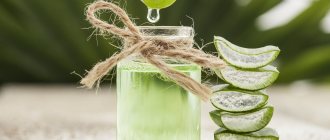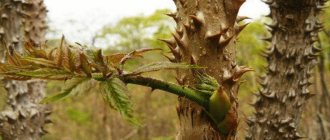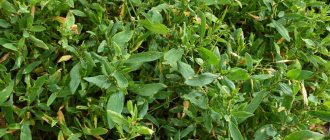Description
Aloe arborescens (genus Aloe) is one of the representatives of the Xanthorrhoeaceae family, known to most people exclusively as Agave, so nicknamed for its rare flowering in cultivation. Being native to South Africa and preferring rocky soils, this species is quite successfully cultivated in our apartments.
An evergreen succulent, Aloe arborescens has a fibrous root system. It is distinguished by long (about 40 cm) juicy, fleshy leaves, with small teeth running along the edges. The leaf, colored green-bluish, sometimes with a bluish tint, is somewhat concave on the outside. In the upper part of the plant, the leaves form a dense rosette, tightly enveloping the stem with their bases.
Drooping tubular flowers of orange color are collected in a lush racemose inflorescence, which bears a long peduncle. When grown at home, it is almost impossible to see this species bloom, but in natural conditions it is a winter-flowering plant. Succulents also usually do not produce fruits in cultivation.
Aloe arborescens is propagated vegetatively - by children growing from the trunk and by the tips of shoots.
How to properly care for an aloe flower (with photo)
An alternative to a prickly cactus can become a pleasant ward for the owner, but how to properly care for an aloe flower?
Endurance and unpretentiousness are the main qualities due to which aloe does not require specific growing conditions. A native of Africa is not spoiled by air humidity: it tolerates dry air, even in apartments with central heating.
For the same reason, it does not require abundant watering: maintain moderate soil moisture; Water less in winter.
Important! Avoid stagnant waterlogging; it leads to damage to the root system, which will become noticeable no sooner than the rot rises up the stem to the leaves, and it will be difficult to save the plant.
Growing aloe at home requires selecting a suitable location: sunny, in summer it is best to place it outdoors in a protected place. Despite its southern origin, being a house flower, aloe does not approve of too high temperatures: room temperature, coolness is necessary in winter. Optimal conditions are 18-20 °C, then the plant will develop quickly.
In different countries, especially in the wild, each type of aloe grows in soil that is slightly different in composition, but, regardless of the variety, an alternative substrate is suitable for all of them: a flower soil mixture with 1/3 sand.
When preparing the soil yourself, you need to take into account that in nature the plant takes root on dry, clay soils with a high iron content and good aeration. Botanists speak well of a mixture of turf, leaf soil, humus and coarse sand.
Sections of turf soil are made on fertile plains (soil layer 7-10 cm thick), carefully monitoring the absence of unrotted inclusions of organic origin. Leaf soil is used as a leavening agent. Only rotted leaves are allowed in it: tougher and harder elements are removed. River sand is washed well before adding to the soil mixture.
Plant parts used
To obtain juice, in which all the beneficial properties of the plant are concentrated, you should use fresh lower and middle leaves of 3-4-year-old Aloe arborescens. They need to be cut off directly at the base of the trunk; the frequency of collection is several times a year. The best time of year to obtain a quality product is summer, although medicinal raw materials can be obtained from cultivated plants in winter.
The finished leaves are cut into small pieces, and the juice is squeezed through cheesecloth, which is consumed immediately or, for the purpose of long-term storage, an alcohol tincture is made from Aloe arborescens.
Care for growing aloe at home: feeding and transplanting from pot to pot (with video)
Caring for the plant at home, the gardener provides it with additional feeding: in the summer, every 3 weeks he applies fertilizer for cacti. In nature, the renewal of the organic and mineral composition of the soil is ensured by rain, the influence of wind, and the vital activity of birds and animals; at home you will have to do this yourself.
Sooner or later, the flower will need to be replanted: adult plants, if necessary, are replanted, on average once every 2-3 years, young plants - once a year. Aloe replanting is required when the flower begins to grow out of its pot, so transfer it to a pot one-fifth larger than the previous one.
The best time for such events is spring and summer, when the plant will receive enough natural light and the optimal room temperature for it is maintained naturally.
When replanting a plant, its roots can be treated with charcoal: it is a natural antiseptic and will prevent the death of the flower if the root system is accidentally damaged or infected. Place a layer of sand or perlite about 5 cm thick on the surface of the substrate - this will prevent the lower part of the stem from rotting.
You can watch the process of caring for aloe at home in the video below:
Ways to use aloe
Internal:
Gastritis, enteritis, constipation - take freshly squeezed aloe juice before meals, 1 teaspoon 2-3 times a day. Duration of treatment is from three weeks to two months.
Irregular stool - 150 g. Grind the fresh leaves (cut off the side spines first), pour in hot, but not boiling honey (300 g) and leave for 24 hours. 5–10 gr. Take the resulting mixture warm in the morning on an empty stomach.
Exhaustion, low immunity - mix 100 grams of juice with chopped walnuts (500 grams), honey (300 grams) and lemon juice (3-4 fruits). Take the resulting mixture 3 times a day, 1 teaspoon half an hour before meals.
External:
Burns, trophic ulcers, abscesses, insect bites - lotions of 1-2 teaspoons of juice, as well as irrigation of inflamed areas of the skin.
Acute rhinitis - 5-8 drops in each nostril 3 times a day with a 5-hour interval between procedures.
Planting and caring for an aloe plant at home: method of propagation by seeds
Experts in growing and caring for aloe distinguish three main methods of propagation: by lateral shoots, shoot cuttings or seeds; they are all applicable at home.
Growing from seeds is the most labor-intensive and painstaking method of propagating aloe, but with its help you can get a real collection of indoor aloe species, because many stores sell mixtures of different seeds. Sowing is done in the spring, in March-April, using small bowls and soil consisting of turf, leaf soil and sand in a ratio of 2:1:2. Water moderately as the seedlings dry out, after which the seedlings are transferred one at a time into small pots.
The soil in them consists of turf and leaf soil and sand in a ratio of 2:2:1, with the addition of charcoal or brick chips. After a year, the plant is considered mature.
It is recommended to treat aloe seeds before planting so that the young flower quickly adapts to home conditions and better accepts care. This can be done in three ways: using potassium permanganate, copper sulfate or boric acid, and aloe juice as a biostimulant.
The potassium permanganate solution for seed disinfection should be weak and pinkish in color. It will protect the shoots from pathogenic bacteria. You can add a little solution to the substrate for the same purpose, but guided by a sense of proportion, since potassium permanganate is a strong oxidizing agent and can burn the seeds if the concentration is exceeded.
Undiluted aloe juice acts as a nutritional cocktail for the seeds. It is mixed with beet or tomato juice, left for a day, after which a gauze bag with seeds is placed in this mixture. In a couple of hours they will be ready to land.
A solution of boric acid or copper sulfate will provide protection against parasites and fungal spores. Keeping the seeds in the solution for a quarter of an hour will provide effective disinfection, after which the seeds, washed with running water, are planted in the soil.
Laxative effect of aloe
The laxative effect of aloe is due to the presence of aloin in it. The juice of the leaves stimulates the appetite, improves digestion, and has a strong tonic effect.
The laxative effect of sabur occurs 8–10 hours after administration. It appears only in the presence of bile in the intestines. Therefore, sabur preparations should not be used by patients with liver and gallbladder diseases.
Sabur is contraindicated for uterine bleeding, hemorrhoids, cystitis, and pregnancy. Sabur preparations are prescribed for chronic constipation orally in the form of powder 0.05 - 0.2 g per dose.
Why do the leaves of an indoor aloe flower turn yellow and dry?
The photo shows a healthy indoor aloe flower:
However, despite all efforts, it happens that the pet begins to waste away. Let's look at the reasons for possible difficulties.
It was mentioned above that for optimal development of a flower, the soil in its pot must be periodically fed with cactus fertilizer.
Excessive depletion of the substrate will inevitably affect the plant: most often it is the answer to the question of why aloe leaves turn yellow.
Fertilizing is not carried out if the plant was replanted less than three weeks ago. During periods of prolonged rain, cool and cloudy weather, plants slow down their metabolism, so fertilizing should be reduced. The optimal composition of mineral fertilizers is considered to be with a high content of potassium, calcium and phosphorus - microelements that are essential for the health of the succulent.
If the grower misses the time for replanting, the root system becomes cramped in the pot, the development of the plant stops, and the supply of nutrients in the substrate is depleted. The flower begins to “lose weight,” that is, to draw out the necessary resource from its own external organs - this is why the tips of aloe leaves dry out.
In this case, you need to transfer outside the schedule. Do not water the plant for several days to make it easier to remove from the pot. If the roots have grown to the sides, the new pot should be wider. If the root system goes deep, you can take a pot of smaller diameter, but high. In the new container the plant should be free and spacious.
Another reason why aloe dries is not enough watering. The succulent wastes moisture without receiving the necessary amount to maintain the supply of fluid in the tissues, and the leaves begin to thin out.
Aloe arborescens appearance
Aloe arborescens is a perennial plant. Its trunk can be different - more or less long. The leaves are numerous and fleshy - up to 60 centimeters in length.
The leaves have an elongated sword-shaped shape with spines along the edges. Usually they are crowded at the top of the trunk in the form of a rosette. The surface of the leaves is flat above and convex below.
The plant has adapted to growing in semi-desert areas. The succulent leaves of aloe with a mucilaginous core retain the moisture reserves needed by the plant.
Propagation of aloe flower by cuttings, top and leaf at home
Propagation of aloe by cuttings is faster and easier; this is one of the most popular methods.
It can be used all year round, but it is preferable to transplant aloe cuttings in the spring and summer, when it is easiest to provide the young animals with light and warmth at home. The cut shoots need to be dried for one or two days, then powdered with crushed coal. It will take away any residual excess moisture and disinfect the cut area. After this, the first planting is carried out - in wet sand to a depth of 1 cm.
After planting, the humidity level in the sand is maintained: it should not dry out, but it should not be flooded. There is no need to cover the plant, because it needs a constant flow of fresh air. By the seventh day, when roots form, the seedling is transferred to a pot where it will mature.
To propagate aloe from the top, it is carefully cut from the plant and placed in a vessel filled with water. Replant when the shoot forms several roots.
For the last method of propagating aloe - by leaf - the grower will have to carry out a small amputation at home. The leaf is completely separated from the stem near the base and removed in the shade until it dries. After this, the cut site is treated with charcoal and placed in a pot with a substrate to a depth of at least 3 cm - this is optimal for the speedy start of the rooting process.
Thus, planting and caring for aloe shoots is very simple, even in a home greenhouse. Regardless of the method of propagation and the type of flower, aloe does not make high demands on the owner.
Optimal soil composition, light, coolness and a balanced amount of moisture - that’s all the prickly doctor needs to turn green and delight the gardener’s eye.
Why does aloe still turn yellow if the soil is sufficiently fertilized and aerated?
As you know, the healthy green tint of plant foliage is due to the presence of chlorophyll, a pigment that helps carry out the process of photosynthesis. With its help, the flower feeds, develops - simply put, lives.
Photosynthesis occurs only in the presence of a sufficient amount of light for a given species: if the plant is too shaded, the metabolism is disrupted, the first symptom of which is a pathological change in the color of the leaves. You need to move the flower pot to a sunnier place, and over time the pigmentation will be restored.
In addition, being in an unfortunate place with limited access to light, the plant begins to reach for its source, which is another reason why the leaves and stems of aloe dry and weaken.
The color of the spots will help the grower make the correct diagnosis. Brown spots indicate a lack of moisture, as does a change in the elasticity of the leaves. If the spots are soft and dark, the flower is most likely affected by a fungal infection; you need to treat the leaves with an antiseptic.
Black spots indicate severe contamination; you need to wipe the plant from dust more often. Redness is a natural reaction to bright lighting, characteristic of agave plants; there is nothing to worry about.
If the leaves suddenly begin to fall off, the aloe was watered with too cold water. Keep the watering can in an area at room temperature, ideally close to the plant pot.
If the leaves wither, turn pale and look sickly, there is too much water in the ground. The watering regime must be changed as quickly as possible before the roots of the plant begin to rot. If the plant begins to turn yellow in the stem, stops growing and falls to one side, it has already contracted root rot. In this case, you need to remove the plant from the pot, inspect and remove all flabby and rotten roots, and cut them off.
Throw away the soil from the pot, wash and disinfect it. A mixture of peat and sand is poured into the pot, where the flower is planted for re-rooting. Water sparingly, using a tray, wetting only the bottom layer of soil. The next watering is not carried out until the soil is completely dry.
The amount of moisture is directly proportional to the temperature of the flower and the amount of sunlight.
If rot has affected the stem, the lower part of the flower is completely cut off until healthy tissue remains. The cut area is sprinkled with crushed coal, dries for 1-2 days, treated with Kornevin and planted as described above.
If small black dots are found on the leaves, the plant is affected by thrips, and the dots are traces of their excrement. The diseased flower is isolated and treated with actara according to the instructions. Repeat 4 times with breaks of 7-10 days. All house plants are given preventive maintenance.
If the green leaves begin to dry quickly, this means that the flower has developed dry rot. She is incurable. For prevention, the entire home collection is periodically treated with systemic fungicides.
What else does aloe vera cure?
- The ability of aloe juice to enhance the formation and release of insulin has been experimentally revealed. Therefore, aloe vera, preparations based on it are prescribed in the initial stages of diabetes mellitus.
- Aloe vera is used for infertility in women and men. There is clinical data confirming an increase in the incidence of pregnancy in women who received aloe orally along with specific therapy for 3–8 months. Aloe extracts increase energy reserves in sperm and enhance their motility.







